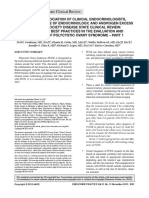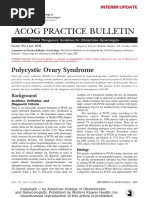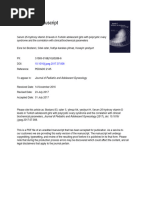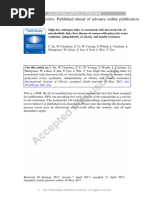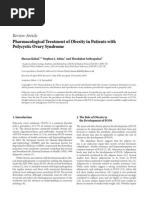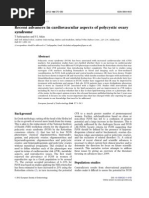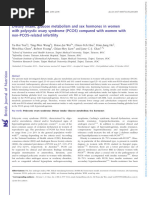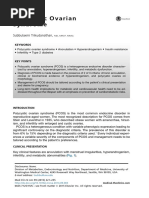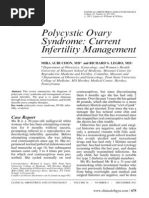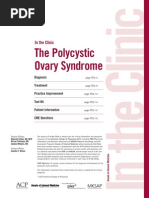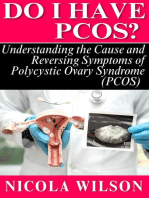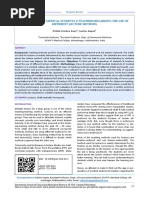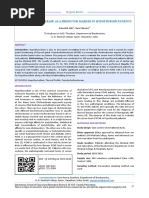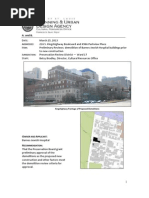H Amruth Et Al
H Amruth Et Al
Copyright:
Available Formats
H Amruth Et Al
H Amruth Et Al
Original Description:
Original Title
Copyright
Available Formats
Share this document
Did you find this document useful?
Is this content inappropriate?
Copyright:
Available Formats
H Amruth Et Al
H Amruth Et Al
Copyright:
Available Formats
Int J Clin and Biomed Res.
2016;2(4): 01-06
Journal homepage: www.ijcbr.com
INTERNATIONAL JOURNAL OF CLINICAL
AND BIOMEDICAL RESEARCH
Research article
STUDY OF SERUM LIPID PROFILE AND FASTING BLOOD SUGAR IN POLYCYSTIC OVARIAN
SYNDROME
SADANANJALI1, SREEKANTHA2, H AMRUTH*3
ABSTRACT
*TINKAL
ARTICLE PATEL
INFO
Received: 4th July 2016
Revised 25th July 2016
Accepted: 5th Aug 2016
AUTHOR DETAILS
1
Postgraduate, 2Proffessor & HOD,
Department of Biochemistry, Raichur
Institute of Medical Sciences, Raichur584102.
3
Medical officer, Health & Family welfare
Department, Gulbarga-585102.
*Corresponding author email:
hukkeri.amruth@gmail.com
Background: Polycystic ovarian syndrome (PCOS) is the multisystemic disorder
and most common reproductive endocrinopathy of women during their
childbearing years, expressed in wide varieties of clinical signs and symptoms. It is
characterized by a varied and often complex array of metabolic and endocrine
abnormalities, including hyperinsulinaemia, hyperglycaemia, glucose intolerance
and obesity which put women with PCOS at a higher risk for diabetes,
hypertension, dyslipidemia, and cardiovascular disease. Objectives: To estimate
Fasting blood glucose and lipid profile in women with PCOS and normal females.
Materials and Methods: After Ethical Committee Approval, blood samples were
collected from 50 diagnosed PCOS cases and 50 healthy controls (premenopausal
women); aged 18 to 40 years. Fasting plasma glucose and lipid profile were
investigated in both PCOS patients and controls. The correlation between these
biochemical parameters were then studied in the PCOS group. Data analysis done
using student t test. Result: There was a significant increase in fasting plasma
glucose levels in PCOS patients as compared to controls. PCOS women had higher
BMI with increased total cholesterol, TGL, LDL-C, VLDL-C and lower HDL-C (P <
0.05) as compared to the controls which was statistically significant. The levels of
glucose showed significant positive correlation with total cholesterol(P<0.01),
triglycerides(P<0.05), LDL-C (P<0.01) whereas non-significant negative correlation
with HDL-C. Conclusion: The findings of this study confirms the association
between Glucose, BMI and dyslipidaemia in PCOS and may help to identify
women with PCOS at risk of cardio metabolic syndrome thereby confirming the
association between PCOS and cardiovascular risk factors.
Keywords: Polycystic Ovarian Syndrome, Dyslipidaemia, Cardio Metabolic
Syndrome, Insulin Resistance.
INTRODUCTION
Polycystic ovarian syndrome (PCOS) is the multisystem
reproductive endocrinopathy with ovarian expression
of metabolic disturbances and a wide spectrum of
clinical features characterized by increased ovarian and
adrenal
androgen
secretion,
hyperandrogenic
metabolic syndrome symptoms such as hirsutism, acne
and/or alopecia, menstrual irregularity and polycystic
ovaries. It is not only a reproductive endocrinopathy
but also a metabolic disorder.[1,2]
The exact prevalence of PCOS is not known as the
syndrome has not been precisely defined. The
estimated prevalence in women of reproductive age is
5-10%.[3]The pathophysiology is complex involving the
hypothalamus-pituitary-ovarian axis, ovarian theca cell
H AMRUTH et al.
hyperplasia, hyperinsulinemia and a multitude of other
cytokine and adipocyte-driven factors.[4]
Women with PCOS share many features in common
with the metabolic syndrome[1] and It is also associated
with an increased risk for metabolic complications like
insulin resistance (IR) with consequent compensatory
hyperinsulinaemia, dyslipidaemia and cosmetic
problems.[5]One of the most prominent metabolic
symptoms of PCOS is insulin resistance, which includes
hyperinsulinaemia and impaired glucose tolerance.They
also develop abnormal glucose metabolism at a
younger age and may demonstrate a more rapid
conversion from impaired glucose tolerance to type2
diabetes mellitus.[6]Impaired glucose tolerance and
diabetes are not only known risk factors for
01
Int J Clin and Biomed Res. 2016;2(4): 01-06
cardiovascular disease but also present with their own
morbidity.
Obesity increases hyperandrogenism, hirsutism,
infertility and pregnancy complications both
independently and by exacerbating PCOS. Likewise, in
PCOS obesity worsens insulin resistance and
exacerbates
reproductive
and
metabolic
[7]
features. Adiposity plays a vital role in the
development and maintenance of PCOS and it strongly
influences the severity of both its clinical and endocrine
features. In addition to abnormal distribution of
adipose tissue in women with PCOS, there may also be
inherent abnormalities of lipolysis within adipocytes
that are site specific[8]. Women with PCOS have
disturbed lipid profiles. The causes of dyslipidaemia in
PCOS are again multifactorial. Insulin Resistance
appears to have a important role; mediated in part by
stimulation of
lipolysis and altered expression of
lipoprotein lipase and hepatic lipase.[9]
IR and dyslipidemia seem to have an important role on
the risk of cardiovascular pathology in women with
PCOS. It is still not known to what degree dyslipidemia
contributes to this risk.[10]
PCOS may represent the largest under-appreciated
segment of the female population at risk of Type2
Diabetes Mellitus and cardiovascular disease. So, it is
recommended that women with PCOS be routinely
screened for indicators of early metabolic changes in
order to anticipate early diagnosis and management. In
view of this, the present study was undertaken to
estimate and correlate the fasting blood sugar levels
and lipid profile that may help to identify women with
PCOS at risk of Cardiometabolic syndrome.
MATERIAL AND METHODOLOGY
The observational case-control study was conducted at
Raichur institute of medical sciences teaching Hospital,
and OPEC super specialty Hospital Raichur from
September 2014-September 2015. Study consists of 50
female patients newly diagnosed with PCOS based on
Rotterdam criteria in the age group of 18-40 years as
cases and 50 age matched healthy female volunteers
with regular menstrual cycles and with no clinical
evidence of hyperandrogenism or PCOS were taken as
control subjects. Institutional ethical committee
approved the study and informed consent obtained
from all the study subjects. All subjects answered a
questionnaire which contained details of age,
H AMRUTH et al.
menstrual history, medical history and family history of
type2 diabetes mellitus or polycystic ovarian syndrome.
Inclusion criteria:
Cases: Female patients newly diagnosed with PCOS
based on Rotterdam Criteria, in the age group of 18-40
years.
Women
with
oligomenorrhoea/Amenorrhoea,
clinical/Biochemical signs of hyperandrogenism
(including: Hirsutism, Acne, Alopecia etc.), elevated
androgen levels, Presence of Polycystic ovaries on USG
were included in the study.
Controls: Age matched healthy female volunteers with
regular menstrual cycles and no signs of clinical
hyperandrogenism or PCOS.
Exclusion criteria:
Women with Diabetes mellitus, hypertension, thyroid
disorders, renal diseases, cardiovascular diseases,
cushing syndrome, pregnant/lactating women, women
on drugs (oral contraceptives, hypoglycemic agents/
lipid lowering drugs), hormonal medicines within 6
weeks were excluded from the study.
Method of collection of data:
A pre-structured and pretested proforma was used to
collect the data. Baseline data including age, BMI,
detailed medical history, family history, clinical
examinations were included as part of the
methodology.
Anthropometric data:
Body Mass Index:
All the subjects height and weight were recorded using
standard apparatus.
Body mass index (BMI) was calculated by dividing
weight (kg) by height (m2).
Normal weight was defined as BMI < 25, Overweight as
BMI between 25.0-29.9 and Obesity as BMI > 30.
Waist circumference and waist:hip ratio
Waist circumference was measured mid-way between
the last palpable rib and the top part of the iliac crest
and the hip circumference was taken around the widest
portion of the buttocks.
Blood Pressure:
Blood Pressure was measured in the right arm, with the
subjects in a relaxed sitting position using a mercury
sphygmomanometer.
02
Int J Clin and Biomed Res. 2016;2(4): 01-06
Sample Collection and Storage:
5 ml of venous blood samples was collected from
healthy controls and women with PCOS after 12 hrs
overnight fast. 1 ml of sample was taken in a tube
containing anticoagulant and analysed for plasma
glucose. 4 ml of sample was taken in a plain tube. After
centrifugation at 3000 rpm for 10 minutes, the serum
samples were incubated for 15 minutes at room
temperature and analysed.
Biochemical Method:
Lipid Profile using standard kits (ERBA: Glucose,TotalCholesterol, Triglycerides, High Density LipoproteinCholesterol [HDL-C]) in Semi- Auto analyser (Mannheim
Erba chem5X) either on the same day of collection or
stored at 2-80C until further analysis.
I. Plasma glucose was analysed by Glucose OxidasePeroxidase Method
II. Serum sample was used for following biochemical
assays:
Lipid Profile:
Total Cholesterol (Cholesterol Oxidase Method);
Triglycerides (Glycerol Phosphate Oxidase and
Peroxidase Method);
High Density Lipoprotein Cholesterol (Phosphotungstic
Acid Method);
LDL-C and VLDL-C were calculated using the
Friedewalds formula:
LDL Cholesterol = [Total cholesterol] - [HDL cholesterol]
[TRIGLYCERIDE]/5;
VLDL Cholesterol = [Triglyceride]/5 (Where all
concentrations are given in mgs/dl)
Statistical Analysis: Data Analysis was performed using
SPSS 16 Software. The values were expressed as mean
Standard Deviation. Deviation and the findings were
analysed by student t test. Pearson's correlation
coefficients were calculated to assess the correlation
between the biochemical parameters in the study
group. A 'P' value of < 0.05 was considered statistically
significant.
RESULTS
Table I shows the mean, standard deviation and P
values of anthropometric measurement, FBS and Lipid
profile in PCOS patients and controls. The mean age of
the PCOS group and the control group were not
statistically significant. PCOS patients had significantly
high BMI (p < 0.01), waist circumference (p<0.001),
Systolic Blood Pressure (P<0.001) and diastolic blood
pressure (P < 0.001) as compared to controls.
H AMRUTH et al.
The PCOS group showed a significantly higher fasting
glucose (P < 0.001). PCOS patients had increased total
cholesterol, triglycerides, LDL-C, VLDL-C and decreased
HDL-C as compared to the controls which were
statistically significant.
Table : shows correlation between various parameters
in PCOS cases. From the table it can be inferred that
BMI (kg/m2) has significant positive correlation with
Fasting blood glucose, total cholesterol, triglyceride,
LDL-c and VLDL-c where as significant negative
correlation with HDL-c. From the table it can be
inferred that Fasting blood sugar level has significant
positive correlation with serum total cholesterol, serum
triglyceride, serum LDL-c and serum VLDL-c whereas
non significant negative correlation with serum HDL-c.
Table 1. Mean, Standard Deviation and P Values of
Anthropometric Measurements, Fasting blood sugar and
Lipid profile in PCOS Patients and Control Groups.
Parameter
Cases (n=50)
Controls(n=50)
P
value
Age (yrs)
26.16 3.77
27.38 5.01
>0.05
BMI (Kg/m2)
27.50 2.54
25.9 2.21
<0.01
Waist
circumference
85.47 5.46
78.24.34
<0.001
Waist Hip ratio
0.786 0.055
0.73840.05
>0.05
SBP (mm Hg)
118.488.79
110.965.92
<0.001
DBP (mmHg)
78.925.47
74.524.19
<0.001
FBS (mg/dl)
97.62 7.19
90.28 8.52
<0.001
165.52 19.21
<0.001
(cm)
Total cholesterol
187.4425.08
(mg/dl)
Triglyceride
138.3 40.32
104.69 32.88
<0.01
HDL-c (mg/dl)
40.64 8.87
45.78 5.86
<0.05
LDL-c (mg/dl)
120.17 28.17
98.79 19.45
<0.001
VLDL-c (mg/dl)
27.61 8.91
20.936.57
<0.01
(mg/dl)
P value of <0.05 considered statistically significant
03
Int J Clin and Biomed Res. 2016;2(4): 01-06
Table 2. correlation of BMI with other parameters in PCOS
BMI(kg/m2)
Parameter
r
Glucose
0.687
<0.01
Total cholesterol
0.691
<0.01
Triglyceride
0.568
<0.01
HDL-c
-0.391
<0.05
LDL-c
0.607
<0.01
VLDL-c
0.498
<0.01
P value of <0.05 considered statistically significant
Table 3. Correlation of Glucose and Lipid profile in PCOS
Parameter
Glucose (mg/dl)
r
Total cholesterol
0.740
<0.01
Triglyceride
0.377
<0.05
HDL-c
-0.251
>0.05
LDL-c
0.699
<0.01
VLDL-c
0.321
<0.05
P value of <0.05 considered statistically significant
DISCUSSION
Considerable evidence has accumulated for the
coexistence of the metabolic syndrome and PCOS. A
key alteration in the former appears to be insulin
resistance which is associated with an increased
morbidity and mortality due to coronary artery disease
with its enormous public health implications. It has
been suggested that inherited defects leading to
peripheral insulin resistance and concurrent
hyperinsulinaemia are among the causative factors for
the development of PCOS. However, due to the
heterogeneity of PCOS, it is unclear whether all subjects
with this disease are equally susceptible to the
symptoms and sequelae of the metabolic syndrome. All
in all, the possibility of an increased risk of coronary
artery disease in women with PCOS warrants effective
diagnostics of the syndrome. Known susceptibility to
coronary heart disease should also be kept in mind
when designing hormonal therapies for PCOS patients.
Clinical manifestations of the metabolic syndrome, i.e.
coronary artery disease and diabetes mellitus, have
H AMRUTH et al.
caused it to be referred to as the 'secret killer'. As
preventive measures can slow down the appearance of
these late symptoms, it is important to recognize at-risk
populations during the symptomless period[11]. Cardio
metabolic syndrome is a clustering of inter related risk
factors that promote the development of
atherosclerotic vascular disease and Type 2 DM. These
interrelated risk factors have direct effect on
atherogenic Dyslipidaemia, elevated blood pressure,
and elevated plasma glucose, and promote
proinflammatory and prothrombotic states.[12]
Obesity is defined as BMI of > 30 and overweight as
BMI of 25-29.9. PCOS patients display central or
abdominal or android obesity, which is characterized by
an increased waist-hip ratio. This visceral distribution of
adipose tissue can be inferred clinically by a waist-hip
ratio of more than 0.85.In our study the mean BMI in
normal healthy women (controls) is 25.92.21(kg/m2)
and in PCOS women (cases) is 27.502.54(kg/m2). The
mean BMI was higher in PCOS cases than controls and
the mean difference was statistically significant
(P<0.01). This is in accordance with other study which
showed that excess visceral fat seems to be predictive
not only of the metabolic syndrome but also of CVD. A
persons waist circumference is the simplest way to
assess central obesity. Waist circumference has been
shown to be one of the most accurate
anthropometrical indicators of abdominal fat.[13]Waist
circumference80 cm in women is considered as a
positive indicator of abdominal obesity as per the
consensus India guidelines for Indian population.[14] In
our study mean waist circumference for normal healthy
women (controls) is 78.24.34 cm and in PCOS
women(cases) is 85.475.46 cm and there was highly
significant statistical difference in the mean waist
circumference values (P<0.001). In the present study
the mean waist hip ratio for normal healthy women
(controls) is 0.73840.033 and in PCOS women (cases)
is 0.7860.0551. The mean waist hip ratio was higher in
cases than controls and the mean difference was not
statistically significant.
In our study mean systolic blood pressure in normal
healthy women (controls) is 110.965.992 mmHg and in
PCOS women(cases) it is 118.488.795 mmHg. The
mean diastolic blood pressure in controls is 74.524.19
mmHg and in cases it is 78.925.473 mmHg. There is
highly significant statistical difference in the mean
blood pressure values (P<0.001).
04
Int J Clin and Biomed Res. 2016;2(4): 01-06
Impaired glucose tolerance (IGT) AND impaired fasting
glucose (IFG) are now referred to as pre-diabetic
indicating the relatively high risk for development of
diabetes in these persons. In the absence of pregnancy,
IFG and IGT are not clinical entities in their own right
but rather risk factors for future diabetes as well as
cardiovascular diseases.[15
The results of our study showed mean fasting blood
glucose in normal healthy women (controls) as
90.288.52 mg/dl and in PCOS women (cases) it was
97.927.196 mg/dl. There was very highly significant
statistical difference in the mean fasting blood glucose
values (P<0.001). Our study also showed significant
positive correlation between fasting blood glucose and
BMI, TG and VLDL-c (P<0.05) and high significant
positive correlation with, TC and LDL-c (P<0.01)
whereas non significant negative correlation with HDL-c
(P>0.05).
V.M. Vinodhini et al., showed no statistically significant
differences in the mean concentrations of fasting
plasma glucose between PCOS patients and healthy
controls[16] whereas, a study by Azevedo MF et al.,
reported higher fasting glucose levels in PCOS women
which was statistically significant.[17]Our result was
consistent with the study of Azevedo MF et al.,. Our
study is consistant with the other study conducted
among 30 pre-menopausal women and 30 healthy
controls, increased fasting glucose levels and decreased
magnesium levels were noted in women with PCOS as
compared to controls and the differences noted were
statistically significant.[3]In another study, impaired
glucose tolerance (IGT), fasting insulin and Homeostasis
Model Assessment of IR (HOMA-IR) were found to be
significantly higher in the study group, when compared
to the healthy controls.[18]In a study conducted among
28 PCOS patients and 24 control women who were
divided into obese and non-obese groups, 75% of the
PCOS subjects presented with insulin resistance
suggesting that insulin resistance not only depends on
the BMI but also on the presence of PCOS.[19]
Obesity is known to have a strong influence on the
prevalence of several metabolic abnormalities in
women with PCOS. The syndrome may be associated
with a change in both lipid and lipoprotein metabolism
(a more atherogenetic lipoprotein pattern is seen in the
presence of obesity). Increase in the triglycerides and
total cholesterol levels and a greater reduction of highdensity lipoproteins (HDLs) have been observed in
H AMRUTH et al.
obese women with PCOS.[20]Our study showed highly
significant statistical difference in the mean values of
TC, TG, LDL-c and VLDL-c in PCOS cases than controls,
the mean values being higher in cases than controls
where as mean HDL-c values were lower in PCOS cases
than controls and the difference was statistically
significant. This is in agreement with the other study
which show that there is an elevation of triglycerides,
cholesterol and LDL-C in combination with decreased
HDL-C and apoA-I.3.
Our study found that HDL-C is lower in PCOS group than
in control group whereas higher mean VLDL was seen in
PCOS compared to controls. This is consistent with the
other study who showed that women with PCOS had
higher triglycerides and VLDL-C with lower HDL2-C and
apolipoprotein A1:A2 ratios.[21]
Another study compared lean and obese PCOS with
control subjects. They also found lower levels of HDL2
cholesterol and higher levels of apolipoprotein B in
PCOS. Obese women had lower levels of HDL-C and
apoA-I with higher triglycerides and VLDL-C.[22]A study
by AnuradhaKalra et al., found no correlation between
BMI with various lipid parameters.[2] But in our
investigation, we found a significant positive correlation
between BMI and total cholesterol, triglycerides, LDL-C,
VLDL-C and significant negative correlation between
BMI and HDL-C. Our study is in agreement with the
another study where the total serum cholesterol,
triglycerides, LDL cholesterol (LDL-C) and Very Lowdensity lipoprotein cholesterol(VLDL-C) were higher in
the women with PCOS and higher BMI. Significantly
lower levels of serum HDL-C were also noted. Positive
correlations were observed between: uric acid and HDLC, glucose and total cholesterol, triglycerides, LDL-C,
and VLDL-C.[3]
Our study showed that PCOS women had higher BMI,
significantly increased total cholesterol, triglycerides,
LDL-C and VLDL-C. On the other hand, serum levels of
HDL-C were significantly lower in this group compared
to controls.
CONCLUSION
The use of these simple biochemical parameters might
prove to be biomarkers in early detection of these
metabolic changes and may help to identify women
with PCOS at risk of cardio metabolic syndrome. Based
on early recognition of PCOS, efforts may be done to
limit or forestall the onset or progression of clinical
symptomatology. In addition, treatment may be
05
Int J Clin and Biomed Res. 2016;2(4): 01-06
instituted in an attempt to prevent or restrict the longterm complications of PCOS namely diabetes and its
related complications, including cardiovascular disease.
However future prospective studies needed in this
aspect. Currently the most effective modalities appear
to be life-style modification and ovarian suppression by
oral contraceptives.
Acknowledgement
We extend special thanks to all the patients and
volunteers who took part in the study, for their kind cooperation.
REFERENCES
1.
Padubidri VG, Daftary SN. Disorders of the Ovary and
Benign Tumours. In: Howkins and Bourne eds. Shaws
textbook of gynaecology. 14th ed. India: Elsevier
Publication. 2008:331.
2. Anuradha Kalra, Sreekumaran Nair, Lavanya Rai.
Association of obesity and insulin resistance with
dyslipidemia in Indian women with polycystic ovarian
syndrome. Indian J Med Sciences 2006; 60(11): 447-53.
3. N. Swetha, RVyshnavi, P. Modagan BalajiRajagopalan. A
correlative study of biochemical parameters in Polycystic
ovarian syndrome. Int J Biol med Res.2013; 4(2):3148-54.
4. Carolyn J. Alexander, Edward P. Tangchitnob, Norman E.
Lepor. Polycystic Ovary Syndrome: A Major
Unrecognized Cardiovascular Risk Factor in Women. Med
Reviews 2009; 2(4).
5. Duleba AJ. Medical management of metabolic
dysfunction in PCOS. Steroids. 2012 Mar 10; 77(4):306
11.
6. Ehrmann DA, Barnes RB, Rosenfield RL, Cavaghan MK,
Imperial J. Prevalence of impaired glucose tolerance and
diabetes in women with polycystic ovary syndrome.
Diabetes care 1992; 22:141-46.
7. Teede H, Deeks A and Moran L. Polycystic ovary
syndrome: a complex condition with psychological,
reproductive and metabolic manifestations that impacts
on health across the lifespan. BioMedCentalMedicine
2010; 8:41.
8. T.M.
Barber,
M.I.McCarthy,
J.A.H.Wasst
and
S.Franks.Obesity and polycystic ovary syndrome.
ClinEndocrinology (2006); 65:137-45.
9. Wild RA, Painter PC, Coulson PB, Carruth KB, Ranney GB.
Lipoprotein lipid concentrations and cardiovascular risk
in women with polycystic ovary syndrome. J Clin
Endocrinol Metab. 1985; 61:946- 51.
10. Ilenia Pepe-Antonino Agrusa-Maria Rita Rinella et al.
Heterogenous Forms of Dyslipidemia in Women With
Polycystic
Ovary
Syndrome.
ActaMedica
Mediterranea.2008; 24:133.
H AMRUTH et al.
11. Anttila L, Rouru J, Penttil T, Irjala K. Endocrinology:
Normal serum uric acid concentrations in women with
polycystic ovary syndrome. Human Reproduction. 1996
Nov 1; 11(11):24057.
12. Dominique Ashen M. Management of cardiometabolic
syndrome in primary and secondary prevention of
cardiovascular disease. Journal for nurse practitioners.
2008; 4(9):670-80.
13. Casella T, Palomba S, Sio ID, Manguso F, Giallauria F,
Simone BD, et al. Visceral Fat is associated with
cardiovascular risk in women with PCOS. Human
Reproduction 2007; 16: 1-7
14. Ganie MA, Marwaha RK, Aggarwal R, Singh S. High
prevalence of polycystic ovary syndrome characteristics
in girls with euthyroid chronic lymphocytic thyroiditis: a
case-control study. Eur J Endocrinol. 2010Jun;
162(6):111722.
15. Salley KE, Wickham EP, Cheang KI, Essah PA, Karjane NW,
Nestler JE. Glucose intolerance in polycystic ovary
syndrome--a position statement of the Androgen Excess
Society. -The Journal of Clinical Endocrinology &
Metabolism.2007; 92(12):4546-56
16. Vinothini VM, Devisri V, Ebenezer William W,
Muthulakshm
M,
Anjalakshichandrasekar
and
Gnanasambandam S. High Sensitive C Reactive Protein
and Apolipoprotein B levels in Polycystic ovary
syndrome: International Journal of Pharma and Bio
Sciences 2012;3(2):719-24.
17. Azevedo MF, Costa EC, Oliveira AI, Silva IB, Marino joice
CD, Rodrigues julieta AM. Elevated blood pressure in
women with Polycystic ovary syndrome: Prevalence and
associated risk factors. Rev. Bres. Ginecol Obstet. (2011);
33(1):31-6.
18. Davies MJ, Norman RJ. Programming and reproductive
functioning. Trends EndocrinolMetab. 2002; 13 : 386-92.
19. Ozanne S, Hales N. Early programming of glucose-insulin
metabolism. Trends EndocrinolMetab 2002; 13:368-72.
20. Gambineri A, Pelusi C, Vicennati V, Pagotto U, Pasquali R.
Obesity and the polycystic ovary syndrome. Int J
ObesRelatMetabDisord. 2002 Jul; 26(7):883-96.
21. Wild RA. Hyperandrogenism. Implications for
cardiovascular disease. Redmond GP (ed). Androgenic
Disorders. New York: Raven Press; 1995.p261-78.
22. Slowiska-Srzednicka J, Zgliczyski S, Wierzbicki M,
Srzednicki M, Stopiska-Gluszak U, Zgliczyski W, et al.
The role of hyperinsulinemia in the development of lipid
disturbances in nonobese and obese women with the
polycystic ovary syndrome. J Endocrinol Invest. 1991 Jul
1; 14(7):56975.
06
You might also like
- International Railway Industry Standard (ISO TS 22163:2017) : UNIFE (Union of European Railway Industries)Document18 pagesInternational Railway Industry Standard (ISO TS 22163:2017) : UNIFE (Union of European Railway Industries)Akshay Kumar50% (2)
- Q2eSE LS4 U05 AudioScriptDocument5 pagesQ2eSE LS4 U05 AudioScriptHanaa Bin Merdah100% (1)
- The Metabolic Syndrome in Polycystic Ovary SyndromeDocument21 pagesThe Metabolic Syndrome in Polycystic Ovary SyndromeHAVIZ YUADNo ratings yet
- NorthAmJMedSci 2015 7 7 310 161246Document8 pagesNorthAmJMedSci 2015 7 7 310 161246Amany SalamaNo ratings yet
- Association of Clinical Features With Obesity and Gonadotropin Levels in Women With Polycystic Ovarian SyndromeDocument4 pagesAssociation of Clinical Features With Obesity and Gonadotropin Levels in Women With Polycystic Ovarian Syndromedoctor wajihaNo ratings yet
- Ovario Poliquístico/Polycystic Ovary SyndromeDocument14 pagesOvario Poliquístico/Polycystic Ovary SyndromeJosé María Lauricella100% (1)
- Chapter 27 The Polycystic Ovary SyndromeDocument4 pagesChapter 27 The Polycystic Ovary Syndromepmj050gpNo ratings yet
- Pcos ApprovedDocument30 pagesPcos ApprovedEsha BhatiaNo ratings yet
- AACE/ACE Disease State Clinical ReviewDocument10 pagesAACE/ACE Disease State Clinical ReviewSanjay NavaleNo ratings yet
- pcosDocument21 pagespcosbigcezarNo ratings yet
- Bpj12 Polycystic Pages 7-13Document0 pagesBpj12 Polycystic Pages 7-13Kimsha ConcepcionNo ratings yet
- Polycystic Ovary Syndrome: A Review (Ricardo Azizz)Document3 pagesPolycystic Ovary Syndrome: A Review (Ricardo Azizz)Jeremy LickteigNo ratings yet
- s41572-024-00511-3Document23 pagess41572-024-00511-3Pediatria HGR220No ratings yet
- Dok PCOSDocument56 pagesDok PCOSasriNo ratings yet
- Pcos - Clinical Case DiscussionDocument4 pagesPcos - Clinical Case Discussionreham macadatoNo ratings yet
- Whats New of PcosDocument9 pagesWhats New of PcosbambangNo ratings yet
- Obesity and The Polycystic Ovary Syndrome - Michael Magnotti, MD, Walter Futterweit, MDDocument18 pagesObesity and The Polycystic Ovary Syndrome - Michael Magnotti, MD, Walter Futterweit, MDPCOS Challenge, Inc.No ratings yet
- POSITION STATEMENTPreDMsop TRTRDocument12 pagesPOSITION STATEMENTPreDMsop TRTRTony CoaNo ratings yet
- Teede 2010 PDFDocument10 pagesTeede 2010 PDFKe XuNo ratings yet
- The Management of Polycystic Ovary Syndrome: Vincenza Bruni, Metella Dei, Valentina Pontello, and Paolo VangelistiDocument15 pagesThe Management of Polycystic Ovary Syndrome: Vincenza Bruni, Metella Dei, Valentina Pontello, and Paolo VangelistiDaniela UrreaNo ratings yet
- Acog 194Document15 pagesAcog 194Marco DiestraNo ratings yet
- NewsletterDocument8 pagesNewsletteraditya599No ratings yet
- Accepted Manuscript: 10.1016/j.jpag.2017.07.008Document25 pagesAccepted Manuscript: 10.1016/j.jpag.2017.07.008Fifi Retiaty YasinNo ratings yet
- Serum Uric Acid Concentration in Overweight and Obese Women With Polycystic Ovary SyndromeDocument8 pagesSerum Uric Acid Concentration in Overweight and Obese Women With Polycystic Ovary SyndromeCristina GaidargiNo ratings yet
- Article - Ghrelin and Leptin in Insulin Resistance (CHECKED)Document6 pagesArticle - Ghrelin and Leptin in Insulin Resistance (CHECKED)pixoguiasNo ratings yet
- 963b5add083b45f88fcdf6bfc06bd882Document40 pages963b5add083b45f88fcdf6bfc06bd882bvkqsfkt6kNo ratings yet
- A Landscape Analysis of The Potential Role of Polyphenols ForDocument21 pagesA Landscape Analysis of The Potential Role of Polyphenols ForAshwini ArmarkarNo ratings yet
- PCOSDocument11 pagesPCOSAshwini ArmarkarNo ratings yet
- The Mechanism of Androgen Actions in PCOS EtiologyDocument12 pagesThe Mechanism of Androgen Actions in PCOS EtiologyXime RdzNo ratings yet
- Polycysticovarysyndrome Inadolescents: Selma Feldman Witchel,, Hailey Roumimper,, Sharon OberfieldDocument16 pagesPolycysticovarysyndrome Inadolescents: Selma Feldman Witchel,, Hailey Roumimper,, Sharon OberfieldAgustina S. SelaNo ratings yet
- PCOS Case Report-3Document12 pagesPCOS Case Report-3Joshua Patrick MuljadiNo ratings yet
- Jhpn0033-0157 Nilai RDocument11 pagesJhpn0033-0157 Nilai RDavid Eka PrasetyaNo ratings yet
- Book Chapter 5Document8 pagesBook Chapter 5vijeta.sopNo ratings yet
- Research ArticleDocument7 pagesResearch ArticleTieti IsaniniNo ratings yet
- Bab IDocument36 pagesBab IDiga AnaNo ratings yet
- V Polycystic Ovarysyndrome: EpidemiologyDocument13 pagesV Polycystic Ovarysyndrome: Epidemiologyrolla_hiraNo ratings yet
- Case Study PcosDocument6 pagesCase Study Pcosapi-315331895No ratings yet
- Clinical Medicine and ResearchDocument26 pagesClinical Medicine and ResearchDavid SuhendraNo ratings yet
- Accepted Manuscript: Diabetes & Metabolic Syndrome: Clinical Research & ReviewsDocument14 pagesAccepted Manuscript: Diabetes & Metabolic Syndrome: Clinical Research & ReviewsPrincipal KMBBNo ratings yet
- Effect of Evening Primrose Oil On HyperandrogenismDocument22 pagesEffect of Evening Primrose Oil On HyperandrogenismCetakdollarNo ratings yet
- 9 - Hyperandrogenemia and Insulin Resistance - The Chief Culprit of Polycystic Ovary Syndrome - 2019Document32 pages9 - Hyperandrogenemia and Insulin Resistance - The Chief Culprit of Polycystic Ovary Syndrome - 2019Johanna Bustos NutricionistaNo ratings yet
- Introduction PCOSDocument14 pagesIntroduction PCOSalex.avenko1030No ratings yet
- Polycystic Ovarian SyndromeDocument2 pagesPolycystic Ovarian SyndromeCarlo CruzNo ratings yet
- Subclinical Hypothyroidism in PCOS, DR Madhushree PahariDocument7 pagesSubclinical Hypothyroidism in PCOS, DR Madhushree PahariMadhushree PahariNo ratings yet
- 12-05-2021-1620815054-8-Ijgmp-3. Ijgmp - Management of Infertility in Polycystic Ovarian SyndromeDocument18 pages12-05-2021-1620815054-8-Ijgmp-3. Ijgmp - Management of Infertility in Polycystic Ovarian Syndromeiaset123No ratings yet
- PCOS CureDocument7 pagesPCOS Curesatmeher5279No ratings yet
- tmp9B90 TMPDocument7 pagestmp9B90 TMPFrontiersNo ratings yet
- Recent Advances in Cardiovascular Aspects of Polycystic Ovary SyndromeDocument9 pagesRecent Advances in Cardiovascular Aspects of Polycystic Ovary SyndromeRuth BritoNo ratings yet
- Tsai 2013 Dietary Intake Glucose Metabolism ADocument9 pagesTsai 2013 Dietary Intake Glucose Metabolism ANasrin SharifiNo ratings yet
- Metabolic Syndrome - Overview and Current GuidelinesDocument12 pagesMetabolic Syndrome - Overview and Current GuidelinessserggiosNo ratings yet
- Dietary Patterns and Polycystic Ovary Syndrome - A Systematic ReviewDocument6 pagesDietary Patterns and Polycystic Ovary Syndrome - A Systematic ReviewKatia Sosa VeraNo ratings yet
- PCOSDocument15 pagesPCOSAndyan Adlu PrasetyajiNo ratings yet
- Sop InfertDocument10 pagesSop InfertdrjosuejauNo ratings yet
- Jurnal Pcos InternationalDocument5 pagesJurnal Pcos InternationalPuput Anistiya Hariani100% (1)
- GTG 33 Pcos 2014Document15 pagesGTG 33 Pcos 2014Juan SetiajiNo ratings yet
- Ovario Poliquistico Articulo 2011Document16 pagesOvario Poliquistico Articulo 2011nikonhpNo ratings yet
- Jpe 3 E05Document6 pagesJpe 3 E05amirreza jmNo ratings yet
- The Relation Between Polycystic Ovarian Syndrome and BMI in Females at Age (15-30) y in Baghdad Medical City From 2015 To 2017Document6 pagesThe Relation Between Polycystic Ovarian Syndrome and BMI in Females at Age (15-30) y in Baghdad Medical City From 2015 To 2017Mariam QaisNo ratings yet
- Metabolic Pro Filing of Polycystic Ovary Syndrome Reveals Interactions With Abdominal ObesityDocument10 pagesMetabolic Pro Filing of Polycystic Ovary Syndrome Reveals Interactions With Abdominal ObesityYuniati ValentinaNo ratings yet
- DownloadDocument1 pageDownloadferrevNo ratings yet
- Hypoglycemia in Diabetes: Pathophysiology, Prevalence, and PreventionFrom EverandHypoglycemia in Diabetes: Pathophysiology, Prevalence, and PreventionNo ratings yet
- Do I Have PCOS? Understanding the Cause and Reversing Symptoms of Polycystic Ovary Syndrome (PCOS)From EverandDo I Have PCOS? Understanding the Cause and Reversing Symptoms of Polycystic Ovary Syndrome (PCOS)Rating: 5 out of 5 stars5/5 (1)
- Perspectives of Medical Students & Teachers Regarding The Use of Different Lecture MethodsDocument4 pagesPerspectives of Medical Students & Teachers Regarding The Use of Different Lecture MethodsInternational Journal of Clinical and Biomedical Research (IJCBR)No ratings yet
- Comparative Study of Lithotripsy and Miniperc in 11 To 18 MM Impacted Puj CalculiDocument5 pagesComparative Study of Lithotripsy and Miniperc in 11 To 18 MM Impacted Puj CalculiInternational Journal of Clinical and Biomedical Research (IJCBR)No ratings yet
- Variations of Origin and Distance of Axillary Nerve: A Descriptive StudyDocument4 pagesVariations of Origin and Distance of Axillary Nerve: A Descriptive StudyInternational Journal of Clinical and Biomedical Research (IJCBR)No ratings yet
- Pseudocholinesterase As A Predictor Marker in Hypothyroid PatientsDocument3 pagesPseudocholinesterase As A Predictor Marker in Hypothyroid PatientsInternational Journal of Clinical and Biomedical Research (IJCBR)No ratings yet
- A Rare Case of Space Occupying Lesion of Brainstem in An Elderly Male PatientDocument3 pagesA Rare Case of Space Occupying Lesion of Brainstem in An Elderly Male PatientInternational Journal of Clinical and Biomedical Research (IJCBR)No ratings yet
- Comparison Between Racemic Bupivacaine and Levobupivacaine Both Combined With Low Dose Fentanyl, Through Intrathecal Route For Transurethral Resection of ProstateDocument4 pagesComparison Between Racemic Bupivacaine and Levobupivacaine Both Combined With Low Dose Fentanyl, Through Intrathecal Route For Transurethral Resection of ProstateInternational Journal of Clinical and Biomedical Research (IJCBR)No ratings yet
- Road Traffic Accidents in India: An OverviewDocument3 pagesRoad Traffic Accidents in India: An OverviewInternational Journal of Clinical and Biomedical Research (IJCBR)No ratings yet
- Comparison of Cervical Biopsy Using Punch Biopsy Forceps Versus Loop ElectrodeDocument7 pagesComparison of Cervical Biopsy Using Punch Biopsy Forceps Versus Loop ElectrodeInternational Journal of Clinical and Biomedical Research (IJCBR)No ratings yet
- A Comparative Study of Topical Betaxalol and Timolol For Their Efficacy and Side EffectsDocument4 pagesA Comparative Study of Topical Betaxalol and Timolol For Their Efficacy and Side EffectsInternational Journal of Clinical and Biomedical Research (IJCBR)No ratings yet
- Influence of Distractions On Audio and Visual Reaction Time in Young Healthy Individual of 19-26 YearsDocument5 pagesInfluence of Distractions On Audio and Visual Reaction Time in Young Healthy Individual of 19-26 YearsInternational Journal of Clinical and Biomedical Research (IJCBR)No ratings yet
- Lutembacher's Syndrome - A Case ReportDocument2 pagesLutembacher's Syndrome - A Case ReportInternational Journal of Clinical and Biomedical Research (IJCBR)No ratings yet
- HbA1C AS AN INDEX OF GLYCEMIC STATUS IN OBESE TYPE 2 DIABETICSDocument6 pagesHbA1C AS AN INDEX OF GLYCEMIC STATUS IN OBESE TYPE 2 DIABETICSInternational Journal of Clinical and Biomedical Research (IJCBR)No ratings yet
- Functional Assessment and Behavior Intervention Plan: Planning FormDocument17 pagesFunctional Assessment and Behavior Intervention Plan: Planning Formapi-281775629No ratings yet
- Download Full Spirituality Religiousness and Health From Research to Clinical Practice Giancarlo Lucchetti PDF All ChaptersDocument65 pagesDownload Full Spirituality Religiousness and Health From Research to Clinical Practice Giancarlo Lucchetti PDF All Chaptersxenderyersan92100% (1)
- Evelina BalzhykDocument1 pageEvelina Balzhykapi-509642710No ratings yet
- Drug Study: Adult: Induction: 40 MGDocument2 pagesDrug Study: Adult: Induction: 40 MGpretty_mary100% (4)
- Republic of The Philippines University Town, Northern Samar Web: EmailDocument5 pagesRepublic of The Philippines University Town, Northern Samar Web: EmailJane MinNo ratings yet
- Instant download Text cases and materials on medical law and ethics 4th Edition Marc Stauch pdf all chapterDocument40 pagesInstant download Text cases and materials on medical law and ethics 4th Edition Marc Stauch pdf all chapterreganswiss3eNo ratings yet
- Hollyfield, Hatfield-RAMS-Rev00 - RedactedDocument34 pagesHollyfield, Hatfield-RAMS-Rev00 - RedactedfilancheshitNo ratings yet
- Gastrointestinal Dan Hepatobilier. Jakarta: Salemba Medika. TEXTBOOK of SURGERY. 17th Edition. Page 2113-2114. PhiladelphiaDocument1 pageGastrointestinal Dan Hepatobilier. Jakarta: Salemba Medika. TEXTBOOK of SURGERY. 17th Edition. Page 2113-2114. PhiladelphiaLaillySufaAskawardaniNo ratings yet
- What Is Counselling A Search For A DefinitionDocument2 pagesWhat Is Counselling A Search For A DefinitionNovianitaNo ratings yet
- Thiruvallur Apr-May 2024Document5 pagesThiruvallur Apr-May 2024chennaizonedraravindsivfNo ratings yet
- OHS Act and Legal LiabilityDocument52 pagesOHS Act and Legal LiabilityMpho SelaiNo ratings yet
- WS Jobs Positive and Negative Statements 2Document2 pagesWS Jobs Positive and Negative Statements 2Marco A. RomeroNo ratings yet
- Document 36Document4 pagesDocument 36Justin TallaferNo ratings yet
- Nanoreservorios Con L-Dopa para Su Liberación ControladaDocument1 pageNanoreservorios Con L-Dopa para Su Liberación ControladaTessy Maria Lopez GoerneNo ratings yet
- Preliminary Reviews: Demolition of Barnes-Jewish Hospital Buildings Prior To New Construction - City St. Louis Preservation Review 3/25/2013Document11 pagesPreliminary Reviews: Demolition of Barnes-Jewish Hospital Buildings Prior To New Construction - City St. Louis Preservation Review 3/25/2013nextSTL.comNo ratings yet
- Downtime, Paper ChartingDocument4 pagesDowntime, Paper Chartinggayman6790No ratings yet
- Print Form - Commissionerate of Health Services, Public Health Department Maharashtra StateDocument3 pagesPrint Form - Commissionerate of Health Services, Public Health Department Maharashtra StatePankaj BhangareNo ratings yet
- Controller Audit On LAFD Response TimesDocument46 pagesController Audit On LAFD Response TimesSouthern California Public RadioNo ratings yet
- Board of Medicine V OtaDocument7 pagesBoard of Medicine V OtaHaidee UyNo ratings yet
- Lab ReportDocument3 pagesLab Reportrahsree100% (1)
- G2 Case Study 1Document18 pagesG2 Case Study 1onguedennis4No ratings yet
- CHAPTER 2 FINAL Business PlanDocument8 pagesCHAPTER 2 FINAL Business PlanAiko ReyesNo ratings yet
- 1.1 Huntleigh Doppler Models FD1 and FD3Document4 pages1.1 Huntleigh Doppler Models FD1 and FD3user 01No ratings yet
- Limnophila (Scrophulariaceae) Chemical and Pharmaceutical Aspects - An UpdateDocument14 pagesLimnophila (Scrophulariaceae) Chemical and Pharmaceutical Aspects - An UpdateKhánh Linh LêNo ratings yet
- Concept of Health and DiseaseDocument4 pagesConcept of Health and Diseaseغدير ميثاق شمخي جبرNo ratings yet
- Conrad & Barker - The Social Construction of IllnessDocument14 pagesConrad & Barker - The Social Construction of Illnesstomaa08No ratings yet
- Parent Engagement StrategiesDocument28 pagesParent Engagement StrategiesChristine Cy100% (2)
- 2009 16 Egg Nutritional DiseasesDocument2 pages2009 16 Egg Nutritional DiseasesSiva MachiNo ratings yet








